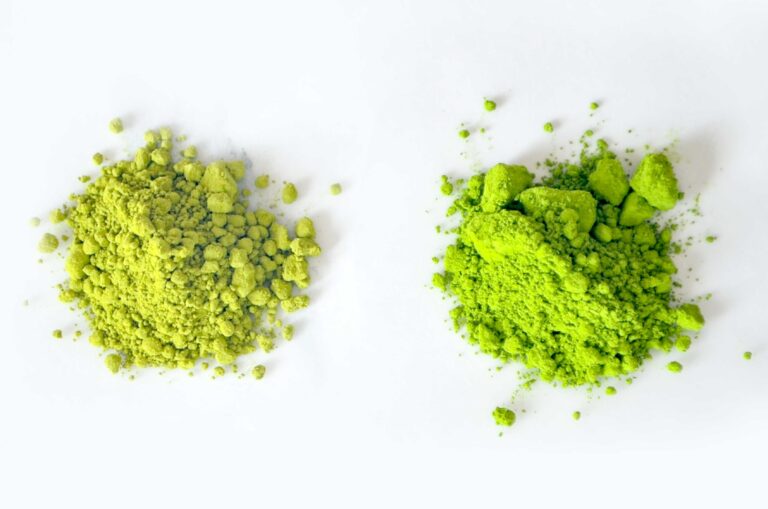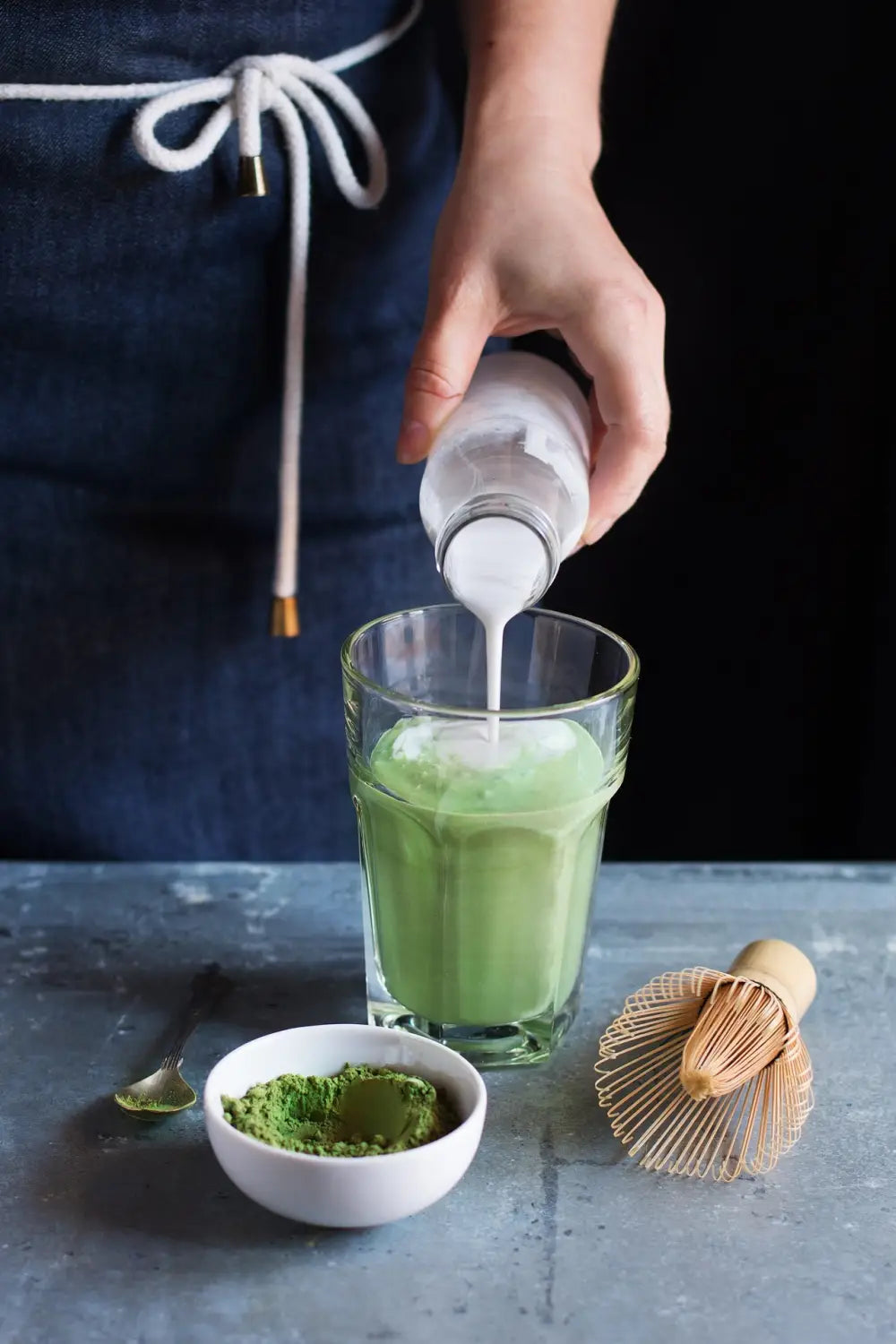

If you have ever wondered as to what is the difference between Green tea and Matcha Green Tea, then you’ve arrived at the right place. Today, we look at two of the most promising, revered healthy beverages - both of which are derived from the same Tea plant - Camellia Sinensis. Both have been held in high regard in Asian cultures for centuries, but there are quite a few differences which make one cup of Matcha as good for you as 10 cups of traditional green tea! Surprised? Let’s dive in!
Cultivation, Harvesting and Processing
Green tea and Matcha green tea are harvested from the same plant, Camellia Sinensis, but unlike traditional green teas, Matcha green tea is cultivated with great care and is shade-grown. Due to scarcity of sunlight, the plant in this case pushes forth additional nutrients to the leaves and this leads to increased levels of chlorophyll. Only the best green tea leaves are selected to make Matcha. This is what gives Matcha the edge over traditional green tea.

The processing part plays a major role in the two types of green teas varying in taste, colour, and versatility. During harvest, green tea is cut and minimally processed using age-old artisanal methods like sun-drying or pan-frying. They could also be processed using modern ways of steaming, oven or tumbler drying. This helps remove some of the bitterness of the leaves and helps preserve the natural vegetal flavour.
Coming to Matcha green tea, the processing is a meticulous one, wherein the leaves are destemmed, deveined, and steamed to stop the oxidation of the leaves. The leaves are then dried and stone-ground to make a fine powder with a lush green colour. Depending on the quality and the use of Matcha, it is available in two grades - Ceremonial Matcha (Higher quality) and Culinary Matcha.

Ceremonial grade matcha ( on the right) is visibly more vibrant, deeper shade of green as it is made of the youngest tea leaves with a higher concentration of chlorophyll. While culinary grade matcha has a more sombre shade of green as it is made of the older tea leaves that have had more exposure to sunlight.
Flavour
Green teas make for a bright cup with delicate flavours with grassy and earthy undertones. The flavour is also influenced by the type of processing and often it can get a bit bitter!
We like curating some flavoursome green tea blends that are unique curations along with some signature favourites as well. Try our ‘sunshine-in-a-cup’ Marigold Green tea or our bestselling Spearmint Green Tea which are beloved blends of our #teatribe.
Matcha green teas, being a fine, vibrant green powder make for a more dense cup with a frothy texture and a richer, sweeter flavour. Snigdha, our Tea Sommelier and Tea Trunk’s Founder, chose a Matcha that is more suited to the Indian palate, is slightly less-bitter, and a great place to start. Give our luscious Berry Matcha Green Tea and our rejuvenating Mint Matcha a try!
Preparing the Cup
Steeping green tea is a simpler affair than brewing Matcha. Boil fresh, filtered water in a saucepan or a kettle to 80℃ or just short of boiling. Pour the hot water over the green tea leaves or tea bag, and never the other way around. Let it steep for 2-3 minutes, depending on how strong you want it to be, strain it, and enjoy a fresh, earthy, grassy cup of green tea.
Brewing a cup of Matcha is a mindful work of art. So special, that there is a dedicated ceremony to it. You can read all about it on our blog - Matcha Tea Ceremony 101. But if you were to brew it at home, like us - we start by taking roughly one teaspoon of ceremonial grade matcha or culinary grade matcha in a Matcha ceramic bowl or a cup. whatever suits the likes of you folks, and hot water is added to it. A traditional Matcha bamboo whisk is used to mix it into a fine paste, removing all lumps and getting a good consistency. More water is added while whisking the cup with the Matcha bamboo whisk. This gives you a luscious cup of frothy and fresh Matcha green tea.
Which Benefits You More?
Let’s be honest! Both are really good for us, owing to the spectrum of health benefits of green tea, but due to the differences in the way they are cultivated, harvested and processed - both these types of teas have their unique benefits as well.

Both Matcha green tea and green tea are a powerhouse of antioxidants, polyphenols, and a special amino acid called ‘L-Theanine’. This is what contributes to the quality of these teas to help improve cognitive functions and make for a healthier caffeine alternative. L-theanine helps in improving your brain’s ability to focus and to remember. It is also known to help improve your mood, sleep and stress levels. Additionally, green teas are known to be good for your heart’s functions, help reduce bad cholesterol levels, help increase endurance levels contributing to better physical performance and this in a way adds to your weight loss efforts too! Green teas are proven to boost your metabolism and help build the body’s immunity by reducing cell damage and protecting your body against a host of illnesses. Remember, no good thing came out of shortcuts! With regular consumption and better choices for your health - green teas can be beneficial for your overall health.
But speaking of Matcha Vs Green Tea, Matcha takes a lead and how! Remember that matcha green tea is made of superior quality tea leaves that are high on nutrients. These are stone-ground to make a fine powder which when mixed with water, retains all of its nutrients. This is ingested as a whole, as compared to green teas - where there is some loss of nutrients.

A study showed that one cup of Matcha green tea is known to have 10 times the antioxidants present in green tea. Matcha green tea contains significantly increased amounts of tannins, amino acids, and caffeine too. While a single cup of green tea contains approximately 70-90 mg of caffeine, as compared to a cup of standard green tea which contains 30-40 mg of caffeine. More caffeine and a higher amount of L-theanine, make Matcha your go-to cup for the morning for it packs a punch but with clean, jitter-free energy ( unlike the daily cup of Joe)
How to find the Right Cup for Yourself?
At Tea Trunk, we love to experiment with blends and variants and find our calling. Everything aside, it’s what works for you the best. This is why we bring you unique variants of whole-leaf green tea blends and a whole range of delicious Matcha green teas, both plain and blended.

Tea Trunk was the first brand to bring Matcha to everyone in India. Now, we are all happy converts! We love the versatility of Matcha and the endless possibilities of what we can curate with it. Get your hands on our in-house recipe of Vegan Matcha Cheesecake Bars or slurp delight of the month - the Rosy Iced Matcha Latte!
We advise trying each variant and seeing what best fits your likes of flavour, consistency, mood. And if this doesn’t make sense, you can always write to your Tea-riffic friends at Tea Trunk!
Until next time,
Happy Sipping



